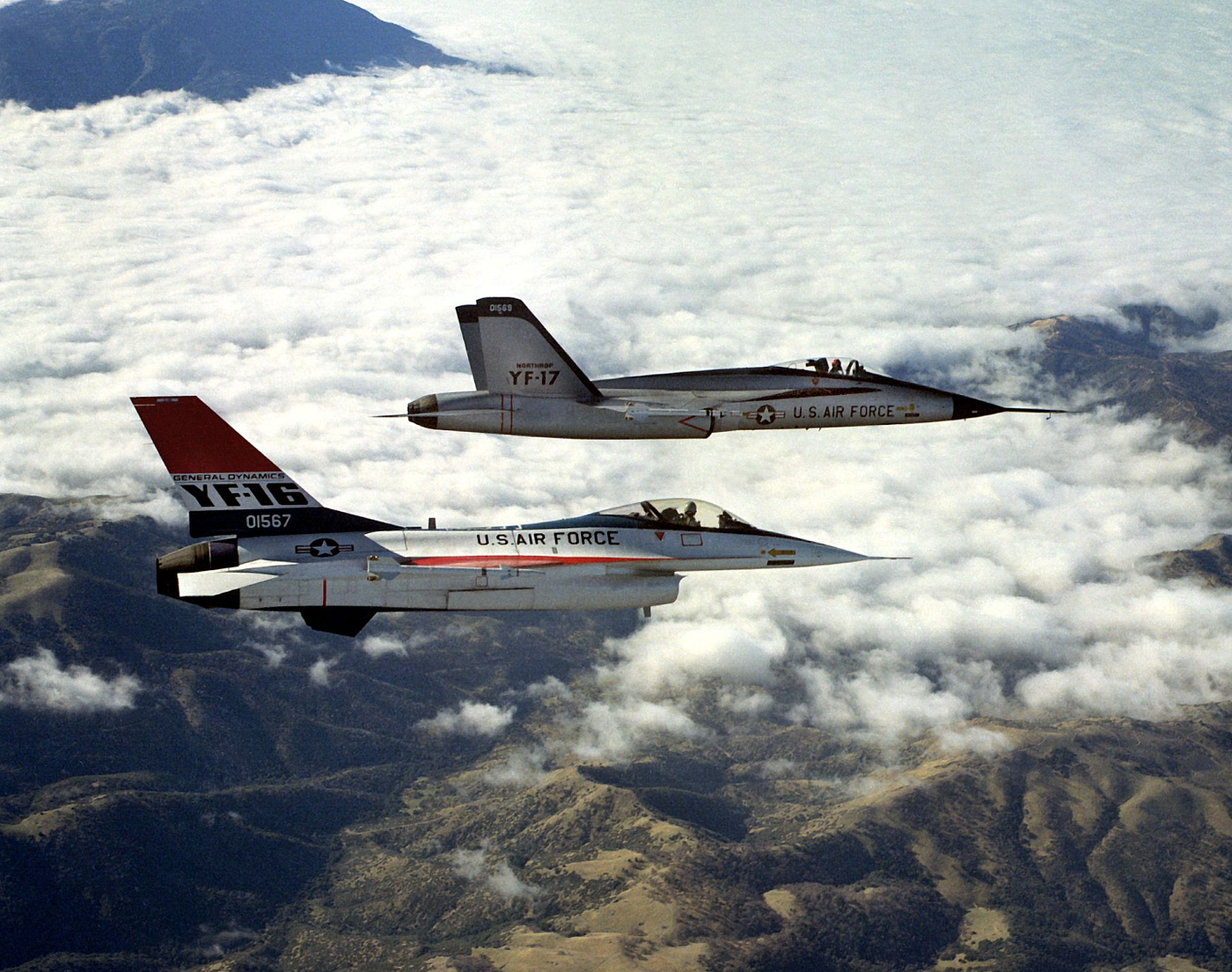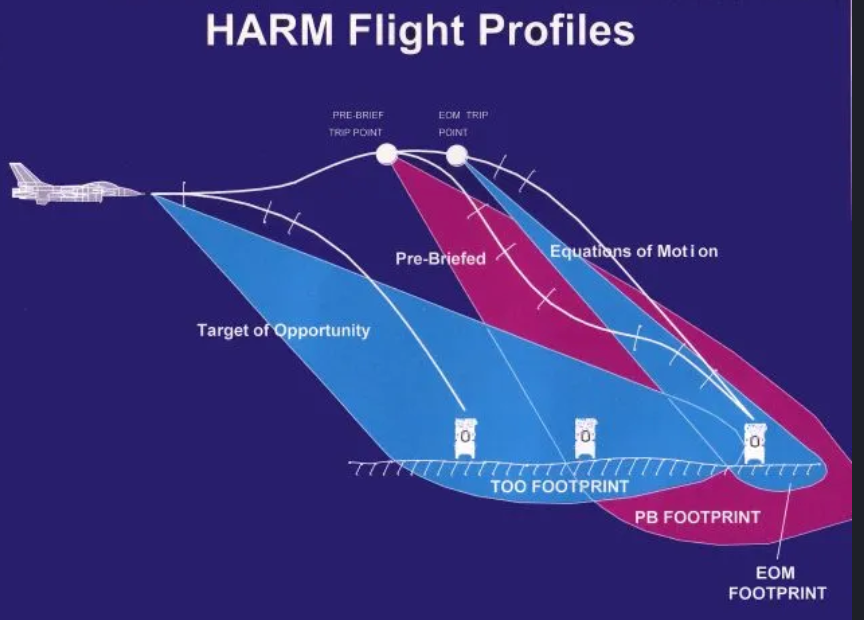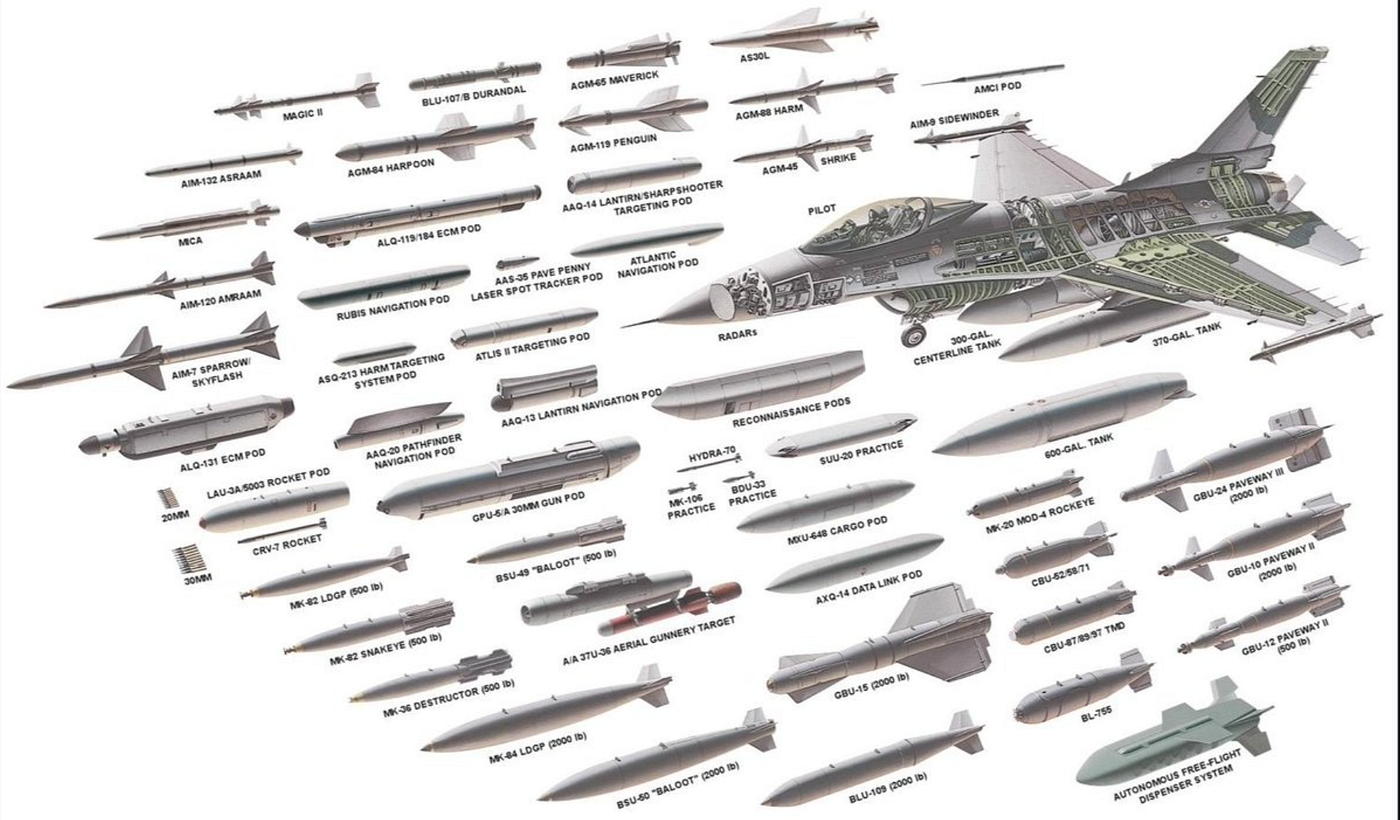Airpower Upgrades: Exploring the F-16 as a Strategic Choic
The F-16 is heading to Ukraine. Let’s look at it’s history.
With multiple announcements of late that the F-16 is heading to Ukraine, we figured it was time to take a further dive into the platform and look at its history and what it can offer while operating on Ukrainian territory. While being one of the worlds most successful light weight fighters, there’s a big difference between the Block 10/15’s that were originally designed through to the current era Block 70 models that are currently flown. It’s these differences we’ll attempt to look at in today’s article as well and the weapons availability and what we can expect to see when they arrive. Both the F/A-18 and F-16 have their origin in the 70/80’s era, Lightweight fighter contest. Source: Wikipedia
Both the F/A-18 and F-16 have their origin in the 70/80’s era, Lightweight fighter contest. Source: Wikipedia
Evolution:
As the 70’s moved in to full swing, there was a new strategic focus on the military. With the Cold War appearing to have no end in sight, and the USSR providing a shock in the form of the MiG-25 Interceptor, the iron curtain remained strong and the pressing need for a technological edge became more important than ever. With 2 Engines, a mach 2 + speed capability and the giant AN/APG-63 Radar the F-15 was an immediate success. Source: Wikipedia
With 2 Engines, a mach 2 + speed capability and the giant AN/APG-63 Radar the F-15 was an immediate success. Source: Wikipedia
With the Air Force sporting the brilliant, but rather expensive F-15A Eagle, the Hi/Low strategy mix came into play.
As part of the Hi/Low strategy, american defense would focus on the F-15 as the High part of the mix, with the Low part of it judged to be a lightweight cost effective fighter that was cheap to produce and run. The reason this strategy came into being was due to that fact that for many simple homeland defense missions, the F-15’s cost and complexity was not needed to complete it’s mission set. With that said, the stage was set for the Lightweight Fighter Contest, with the YF-16 facing off against the YF-17 for the coveted contract.
With Fighter Dynamics at the time revolving around a theory called Energy Maneuverability the influence of this theory would play a significant part in the design of the F-16 with the original calls being for a pure lightweight day fighter, with infra red AIM-9 Missiles and a 20mm Canon and no radar, ground attack system or other weight imposing systems.
Because of this, the two entrants to the light weight fighter contest were fast, maneuverable fighters with a heavy focus on basic fighter maneuvering and short range, infra red AIM-9 missiles as the primary air to air weapon.
However the F-16 had one unique edge. It was powered by the GE F110 turbofan engine, the same model that powered the USAF’s F-15. This gave the new fighter a commonality advantage, meaning it was able to tap into the same logistics pipeline that was already used by multiple versions of the F-15. The GE F110 turbofan provided commonality between the F16 & F15. Source: Wikipedia.
The GE F110 turbofan provided commonality between the F16 & F15. Source: Wikipedia.
While the winner for the air force was the F-16, the Navy decided it preferred the reliability of a twin engine air frame and announced it would be going with a modified version of the YF-17 which would eventually become the F/A-18A Hornet. With both the F-16 and the F/A-18 remaining in service to this day, it’s fair to say the United States got their moneys worth from this particular program.
Electronics & Weapon Upgrades:
While the early models were simplistic fighters, the technology push in the 80s meant things weren’t going to be that way for very long. As jet engine reliability improved and the military looked for ways to maximize their return on investment, dedicated single role platforms like interceptors started to lose their shine, with a renewed focus on the “multi role” fighter that had the ability to work targets both in the air and on the ground.
The first upgrades down this path appeared in the 80’s with the integration of the Low Altitude Navigation, Targeting Infra Red for Night pod, also known as LANTIRN. LANTIRN provided thermal and infrared navigation and targeting capabilities, giving the F-16 the capacity to operate as an all weather fighter. LANTIRN pod imagery as integrated on the F-15 Strike Eagle. LANTIRN gives all weather targeting and navigation capabilities to the F-16. Source: Wikipedia.
LANTIRN pod imagery as integrated on the F-15 Strike Eagle. LANTIRN gives all weather targeting and navigation capabilities to the F-16. Source: Wikipedia.
The integration of this pod provided a massive weapons upgrade to the F-16 with many guided weapons now being an option. This meant that the GPS guided Joint Direct Attack Munition was now an option as was the Paveway laser guided series, along with the laser guided AGM-45 Maverick missile.
These upgrades gave the F-16 legitimate ground attack capability and the 1990’s — 2000 era continued to see further weapons upgrades with the integration of the AGM-154 JSOW Glide Bomb and AGM-158 JASSM cruise missile as well as a new, more efficient radar.
The AN/APG-68 radar provided an enhanced air to air capability to the F-16. As we mentioned earlier the A model was intended to be a pure air to air fighter. However the increasingly more complex list of upgrades meant the F-16 was given a beyond visual range capability, first carrying the semi active homing, cold war era AIM-7 Sparrow before being upgraded to the much more effective AIM-120 AMRAAM in the late 90s. The integration of the active, radar homing AIM-120 was the last step towards turning the lightweight fighter into a capable, multi role variant with all weather air to ground capability and the ability to destroy aerial targets at over 100km distance.
The last notable upgrades to the F-16 came in the 90’s with the retirement of the F-4G Phantom from the suppression of enemy air defense role.
The Phantom, which was a dedicated Wild Weasel hunter was replaced with a variant of the F-16 known as the F-16CJ. With the integration of the AGM-88 High Speed Anti Radiation Missile and a dedicated targeting pod known as the Harm Targeting System, the F-16 took over from the F-4 and provided a dedicated platform with which to conduct the SEAD role. We’ll look at why this is important shortly, but if you’re interested in reading more about the Wild Weasel role, check out our previous article on them here. F-4G Wild Weasel in Bahrain during Operation Desert Shield. Source: Wiki
F-4G Wild Weasel in Bahrain during Operation Desert Shield. Source: Wiki
Why The F-16 Is Important:
Now we’ve looked at the development of the F-16 it’s time to look at why it’s so important in this conflict. But before we do that, there is one thing we are to clearly understand first.
Essentially while the F-16 was designed for and evolved to do many jobs there’s one clear thing that the platform was designed to do and that’s destroy Soviet fighters during a cold war gone hot. More importantly it was designed to do it from both the continental United States as well as from European bases. So without looking at anything else we know the F-16 is comfortably designed to tackle European ranges and conditions. However there’s three other good reasons as to why the F-16 is ideal for Ukraine and they revolve around the eventual goal of air superiority. F-16C Carrying top to bottom. AIM-120 AMRAAM, AIM-9L Sidewinder, AGM-88 HARM and LANTIRN on the center line. Source: Wikipedia.
F-16C Carrying top to bottom. AIM-120 AMRAAM, AIM-9L Sidewinder, AGM-88 HARM and LANTIRN on the center line. Source: Wikipedia.
The AGM-88 Harm:
While we’ve seen the HARM pop up before and written about it ourselves in this article one thing we clearly mentioned is that while this brings the HARM into battle it does so in a limited capacity, with far less of the capability you’d see when integrated to the F-16. Having the F-16 as a launch platform would give Ukrainian forces the ability to take full control of the HARM and leverage it’s entire range of capabilities.
This is important because though out this entire conflict no side has been able to obtain adequate air superiority and as such, we see air power taking a lessor role in the conflict. Obtaining air superiority starts with the degradation of Integrated Air Defense systems and using the full capabilities of the HARM is where this objective starts.
While it’s unreasonable to assume we’d see large scale suppression missions similar to what we’ve seen from the USAF, the ability to bring HARM to the battlefield at any time and threaten S300 and S400 systems means that the grinding down of Russian air defense components can continue making it harder, and more costly to deny the Ukrainians use of their airspace. It also brings a psychological aspect to the battle, with Air Defense forces much less inclined to put them selves at risk lest they attract a missile strike for their troubles. F-16 provides an increased envelope for AGM-88 operations. Source: Ausairpower.net
F-16 provides an increased envelope for AGM-88 operations. Source: Ausairpower.net
Russian Flight Operations:
While the back and forth nature of air superiority has caused problems, one ongoing issue through the conflict has been the operation of various aviation platforms within Russian airspace. While this has taken a number of different approaches, there are two issues here that are particularly notable. Firstly, long range strategic bombers operating deep within Russian airspace are able to fire cruise missile with impunity, due to the Ukrainians possessing little in the way of a viable intercept strategy.
Secondly the operation of high performance tactical fighters inside Russian airspace has hindered the Ukrainian forces, with the fighters using both long range look down radar and the R77 missile to harass aircraft operating near to the front.
Both of these issues occur because of a missile and performance mismatch. While the MiG-29 is still a reasonably proficient fighter, it’s lightweight much like the F-16. This means it has limited range, a smaller radar and does not carry the long ranged R-77 missile, using the medium range R-27 missile instead.
This mismatch between weapons is some 50km in range depending on the launch envelope and means that at this point these tactical platforms are able to operate without being threatened. While the AIM-120 is no silver bullet for this situation it will give the Ukraine forces the ability to start to chip away at this advantage as well as giving a limited ability to provide pop up attacks, eating away at the advantage currently sported by Russian MiG’s. MiG-31 carries both R-77 missile as well as Kh-47 Kinzhal, meaning they are a priority target. Source: Wikipedia.
MiG-31 carries both R-77 missile as well as Kh-47 Kinzhal, meaning they are a priority target. Source: Wikipedia.
Lastly, F-16 also has a full Link 16 data link capability meaning targeting data is able to be freely shared with other F-16 platforms as well as ground based Patriot missile systems. This provides a force multiplier effect, allowing F-16’s to operate in an area without having to use their own radar for situational awareness.
NATO Logistics Pipeline:
The last and in our opinion most important reason for integration though is good old logistics. We’ve referenced the saying “Amateurs talk tactics while professionals talk logistics” before and tried to impart on readers the importance of good logistics in providing ongoing defense. The F-16 is no different.
One of the biggest advantages provided by the NATO method of standardization is a streamlining of weapons, munitions and other essential military components, known as STANAG. Let’s pause for a minute and ask Chat GPT why this is advantageous.
Input: Why is STANAG important?
Output: STANAG, which stands for “Standardization Agreement,” is a term used to describe a series of standardized agreements or protocols used by member countries of the North Atlantic Treaty Organization (NATO) and other allied nations. These agreements cover a wide range of military and technical standards and are essential for ensuring interoperability and compatibility among NATO and allied forces. Here are several reasons why STANAG agreements are important:
1. **Interoperability**: STANAGs ensure that military equipment, systems, and procedures used by NATO and allied nations are compatible and can work together seamlessly. This is crucial for joint operations and coalition forces where different countries may contribute personnel and equipment.
2. **Efficiency**: By adhering to common standards and procedures, member nations can reduce duplication of effort, streamline logistics, and enhance overall efficiency in military operations and acquisitions. This can result in cost savings and improved resource allocation.
3. **Communication**: STANAGs standardize communication protocols, including radio frequencies, encryption methods, and data formats. This enables effective communication between military units from different nations, enhancing situational awareness and coordination on the battlefield.
4. **Equipment Compatibility**: Standardized equipment specifications ensure that military hardware and software can be used interchangeably or integrated across different countries’ armed forces. This simplifies the procurement process and can reduce maintenance and support costs.
5. **Training and Doctrine**: STANAGs can cover training and doctrine, helping to align military procedures, tactics, and training programs among NATO and allied nations. This ensures that personnel are prepared to work together effectively.
6. **Logistics and Supply Chains**: Standardization in logistics and supply chain procedures helps ensure that critical supplies, equipment, and ammunition can be shared or sourced efficiently during deployments or humanitarian missions.
7. **Cybersecurity**: In the modern era, STANAGs also encompass cybersecurity standards, helping to protect military networks and systems from cyber threats. Standardized security measures are crucial for safeguarding sensitive military information.
8. **Rapid Deployment**: STANAGs can help speed up the deployment of forces in crisis situations. Common standards for transportation, equipment handling, and base setup facilitate rapid response to emerging threats.
9. **Alliance Cohesion**: STANAGs promote cohesion and unity among NATO and allied nations. They reinforce the commitment to collective defense and cooperative security, underpinning the strength of the alliance.
10. **Global Partnerships**: Beyond NATO, STANAGs are often used as a basis for cooperation and interoperability with non-NATO nations participating in international military operations, such as peacekeeping missions or disaster relief efforts.
In summary, STANAG agreements are essential for enhancing the effectiveness, efficiency, and cohesion of NATO and allied military forces. They facilitate interoperability, communication, and cooperation, which are vital in a complex and interconnected world where international security challenges require multinational responses.
So we see that standardization provides increased logistics and a focus on sharing and interchangeability and as the Ukrainian Defense Force continues to grow this becomes more and more important.
While Ukraine started with a large stockpile of various types of soviet era munitions, over the course of the conflict this has naturally declined, leading to a large array of assorted equipment types operating within the conflict. While this is to be expected, the large stockpile of soviet equipment means that there is little compatibility between those and western lend lease systems. So we see a more complex logistical pipeline along with less focus on precision guided munitions. The F-16 has a vast array of weapons for both air to air and air to ground roles. Source: Reddit
The F-16 has a vast array of weapons for both air to air and air to ground roles. Source: Reddit
Adopting standardization means that Ukraine unlocks the full power of the logistical pipeline, meaning they can tap in to a vast munitions stockpile of both air to air and air to ground weapons systems.
While it’s reasonable to expect many high end weapons systems will not be supplied even being able to tap into the AIM-120, AIM-9 and JDAM pipeline will provide a significant weapons capability upgrade along with increased performance to boot.
In Closing:
It’s important to note there are other good reasons as to why F-16 is a viable choice. We’ve just chosen 3 of what we feel are the most prevalent to review today. And while many will claim this is a complex platform that is outside the scope of the Ukrainians, the fact is they have shown great ingenuity in applying western weapons to this conflict, all while expanding indigenous capability upgrades of their own.
As we can see with many advantages the F-16, while not expected to be a silver bullet solution shows clear benefit when added to the order of battle, providing an expansion of air power within the scope of this conflict.
Probably the only question now is when can we expect to see them turn up??
If you’d like to assist Ukraine in the defense of their homeland, you can do so via this link.
🌟 Enjoyed this article? Support our work and join the community! 🌟
💙 Support me on Ko-fi: Investigator515
📢 Join our Telegram channel for exclusive updates or.
🐦 Follow us on Twitter
🔗 Articles we think you’ll like:
- OSINT Unleashed: 5 Essential Tools for Cyber Investigators
- What the Tech?! GPS Technology
✉️ Want more content like this? Sign up for email updates here





![[FAILED] Engage2Earn: McEwen boost for Rob Mitchell](https://cdn.bulbapp.io/frontend/images/c798d46f-d3b8-4a66-bf48-7e1ef50b4338/1)

















































![[ℕ𝕖𝕧𝕖𝕣] 𝕊𝕖𝕝𝕝 𝕐𝕠𝕦𝕣 𝔹𝕚𝕥𝕔𝕠𝕚𝕟 - Is Trump Dying? Or Only Killing The Market?](https://cdn.bulbapp.io/frontend/images/a129e75e-4fa1-46cc-80b6-04e638877e46/1)






